Find more information in the General Comments section of the assessment
Find more information in the Rating Validity tab of the assessment
- See More
- See More
- See More
- See More
- Good
- Adequate
- Marginal
- Weak
- Poor
 Passenger
Passenger
 Driver
Driver
 Front Seat
Front Seat
 Car
Car
 Pole
Pole
- Good
- Adequate
- Marginal
- Weak
- Poor


Passenger
outboard
Fitted to the vehicle as standard
Not fitted to the test vehicle but available as option
Not Available
-
Infants up to 13 kg
-
Infants and toddlers up to 18 kg
-
Toddlers from 9 to 18 kg
-
Toddlers over 18 kg
Easy
Difficult
Safety critical
Not allowed
| Seat Position | ||||
|---|---|---|---|---|
| Front | 2nd row | |||
| Passenger | Left | center | Right | |
| Maxi Cosi Cabriofix (Belt) | ||||
| Britax Römer King Plus (Belt) | ||||
| Britax Römer Duo Plus (ISOFIX) | ||||
| Britax Römer KidFix (Belt) | ||||
| Maxi Cosi Cabriofix & EasyFix (Belt) | ||||
| Maxi Cosi Cabriofix & EasyFix (ISOFIX) | ||||
| BeSafe iZi Kid X3 ISOfix (ISOFIX) | ||||
| Maxi Cosi Pearl & Familyfix (ISOFIX) | ||||
| Britax Römer KidFix (ISOFIX) | ||||
Easy
Difficult
Safety critical
Not allowed
Based on dummy readings in the dynamic tests, the Cherokee scored maximum points for its protection of both the 3 year and the 1½ year infants. Forward movement of the 3 year dummy, sat in a forward-facing restraint, was not excessive and, in the side impact, both dummies were properly contained within the protective shells of their restraints, minmising the likelihood of dangerous head contact with parts of the car interior. The airbag for the front passenger seat cannot be disabled so a rearward-facing child restraint should not be used in that seating position. The labels warning of the dangers of doing so were not permanently attached to the sun visor, so did not meet Euro NCAP's requirements. All the types of child restraints for which the car is designed could be properly installed and accommodated in the vehicle.
- Good
- Adequate
- Marginal
- Weak
- Poor

Head Impact 16.9 Pts
Pelvis Impact 1.6 Pts
Leg Impact 6.0 Pts
The bumper provided good protection to pedestrians' legs in all areas tested, and scored maximum points. However, the front edge of the bonnet showed poor levels of protection to the pelvis region in most test locations. The bonnet surface gave mixed results, with good and adequate performance in many areas and poor results primarily around the stiff windscreen pillars.
- Good
- Adequate
- Marginal
- Weak
- Poor
| Speed Limitation Function | Manually Set |
| System Name | ESC | |
| Performance | ||
| Vehicle Yaw Rate @ COS + 1.00 s | 1.962% | meets ECE requirements |
| Vehicle Yaw Rate @ COS + 1.75 s | 2.344% | meets ECE requirements |
| Lateral Displacement @ BOS + 1.07 s | 2.91 m | meets ECE requirements |
| Applies To | All seats | ||
| Warning | Driver Seat | Front Passenger(s) | Rear Passenger(s) |
| Visual | |||
| Audible | |||
|
|||
Electronic stability control is standard equipment on all Jeep Cherokees, and the system met Euro NCAP's test requirements. The car also has a standard-fit seatbelt reminder system covering the front and rear seats. A driver-set warning-only speed assistance system is standard and met the test requirements for systems of that type.
- Specifications
- Safety Equipment
- Videos
- Rating Validity
Specifications
Tested Model Jeep Cherokee 2.0 diesel 'Longitude', LHD
Body Type - 5 door SUV
Year Of Publication 2013
Kerb Weight 1788kg
VIN From Which Rating Applies - applies to all Cherokees of the specification tested
Class Small SUV
Safety Equipment
Note: Other equipment may be available on the vehicle but was not considered in the test year.
Fitted to the vehicle as standard
Fitted to the vehicle as option
Not fitted to the test vehicle but available as option
Not Available
Not Applicable
Videos
Rating Validity





Find more information in the General Comments section of the assessment
 Share
Share
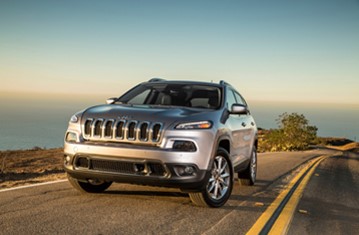
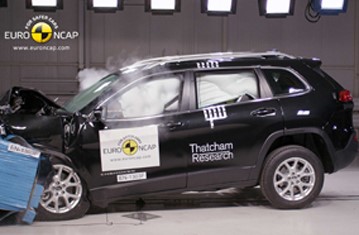
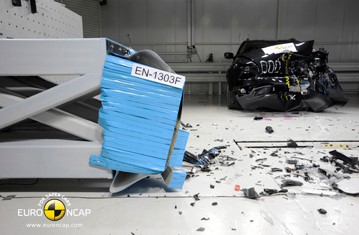
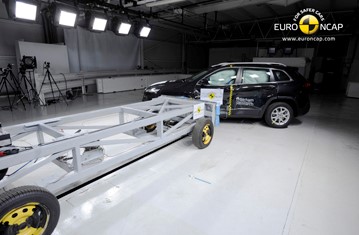
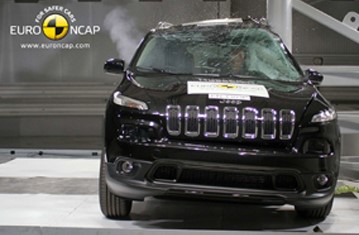




The passenger compartment remained stable in the frontal impact. Dummy readings indicated good protection of the knees and femurs of both the driver and passenger. Jeep showed that a similar level of protection would be provided to occupants of different sizes and to those sat in different positions. In the side impact barrier test, the Cherokee scored maximum points with good protection of all body regions. In the more severe side impact pole test, protection of the chest was adequate and that of other body regions was good. The seats and head restraints provided marginal protection against whiplash injuries in the event of a rear-end collision.